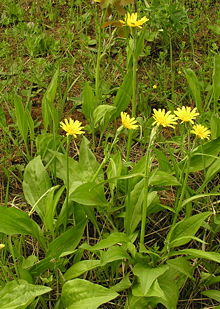Scorzonera
| Scorzonera | |
|---|---|

| |
| Scientific classification | |
| Kingdom: | Plantae |
| Clade: | Tracheophytes |
| Clade: | Angiosperms |
| Clade: | Eudicots |
| Clade: | Asterids |
| Order: | Asterales |
| Family: | Asteraceae |
| Tribe: | Cichorieae |
| Subtribe: | |
| Genus: | Scorzonera L. |
| Synonyms[1] | |
| |
Scorzonera is a genus of flowering plants in the dandelion tribe within the daisy family.[2][3]
They are distributed in Europe, Asia,[3] and Africa.[4] Its center of diversity is in the Mediterranean.[5] Well-known species include the edible black salsify (Scorzonera hispanica). Scorzonera tau-saghyz is a source of natural rubber.[6][7][8]
Scorzonera is recorded as a food plant for the larva of the Nutmeg, a species of moth.
Species[]
The genus contains the following species.[1][9]
- S. hispanica – black salsify, Spanish salsify, viper's-grass, black oyster plant
- S. humilis – viper's grass
- [10]
- S. laciniata
- S. libanotica
- S. tau-saghyz
- [4]
Etymology[]
| Wikimedia Commons has media related to Scorzonera. |
One possible origin of the genus name is the French scorzonère ("viper’s grass").[3]
Secondary metabolites[]
Some Scorzonera species contain lactones, including members of the guaianolide class of sesquiterpene lactones.[11] Flavonoids found in Scorzonera include apigenin, kaempferol, luteolin, and quercetin.[12] Other secondary metabolites reported from the genus include caffeoylquinic acids, coumarins, lignans, stilbenoids, and triterpenoids.[13] One unique class of stilbenoid derivative was first isolated from Scorzonera humilis. They were named the after Tyrol in the eastern Alps, where the plant was collected.[14]
References[]
- ^ a b Flann, C (ed) 2009+ Global Compositae Checklist
- ^ Bremer, K. (1994). Asteraceae: Cladistics and Classification. Timber Press, Portland. ISBN 978-0881922752.
- ^ a b c Scorzonera. Flora of North America.
- ^ a b Duran, A. and E. Hamzaoglu. (2004). A new species of Scorzonera (Asteraceae) from South Anatolia, Turkey. Biologia-Bratislava 59(1), 47-50.
- ^ Karaer, F. and F. Celep. (2007). Rediscovery of Scorzonera amasiana Hausskn. and Bornm. – A threatened endemic species in Turkey. Bangladesh Journal of Botany 36(2), 139-44.
- ^ Buranov, A. U. and B. J. Elmuradov. (2010). Extraction and characterization of latex and natural rubber from rubber-bearing plants. Journal of Agricultural and Food Chemistry 58(2), 734-43.
- ^ Flora of China Vol. 20-21 Page 198 鸦葱属 ya cong shu Scorzonera Linnaeus, Sp. Pl. 2: 790. 1753.
- ^ Altervista Flora Italiana, genere Scorzonera includes photos and distribution maps
- ^ "The Plant List". Retrieved 22 June 2014.
- ^ Parolly, G. and N. Kilian. (2003). Scorzonera karabelensis (Compositae), a new species from SW Anatolia, with a key to the subscapigerous Scorzonera species in Turkey.[permanent dead link] Willdenowia 33 327-35.
- ^ Zidorn, C. (2010). "Sesquiterpene lactones and their precursors as chemosystematic markers in the tribe Cichorieae of the Asteraceae". Phytochemistry. 69 (12): 2270–96. doi:10.1016/j.phytochem.2008.06.013. ISSN 0031-9422. PMID 18715600.
- ^ Sareedenchai, V. and C. Zidorn (2010). "Flavonoids as chemosystematic markers in the tribe Cichorieae of the Asteraceae". Biochemical Systematics and Ecology. 38 (5): 935–57. doi:10.1016/j.bse.2009.09.006. ISSN 0305-1978.
{{cite journal}}: CS1 maint: uses authors parameter (link) - ^ Jehle, M. et al. (2010). "Natural products from Scorzonera aristata (Asteraceae)". Natural Product Communications. 5 (5): 725–27. doi:10.1177/1934578X1000500510. ISSN 1934-578X.
{{cite journal}}: CS1 maint: uses authors parameter (link) - ^ Zidorn, C. et al. (2000). "Tyrolobibenzyls ‒ Novel secondary metabolites from Scorzonera humilis". Helvetica Chimica Acta. 83 (11): 2920–25. doi:10.1002/1522-2675(20001108)83:11<2920::AID-HLCA2920>3.0.CO;2-5. ISSN 0018-019X.
{{cite journal}}: CS1 maint: uses authors parameter (link)
- Asteraceae genera
- Cichorieae
